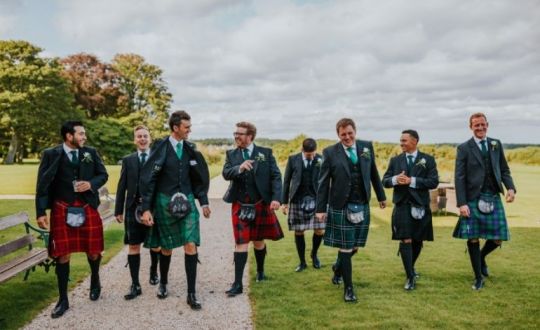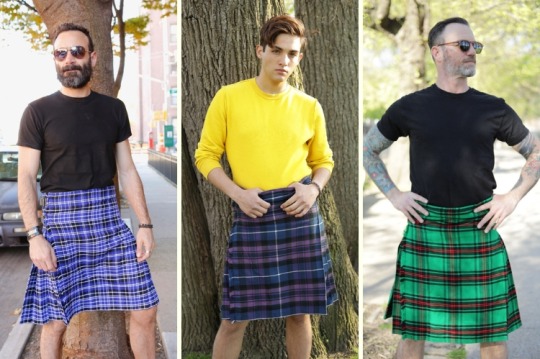#clankilt
Text
Unlocking the Allure of Clan Kilts: 8 Yard vs. 5 Yard Kilt
In this article, we'll delve into the captivating world of Clan Kilts, exploring the key differences between 8-yard and 5-yard kilt. Whether you're a passionate Scotsman or a kilt enthusiast from afar, understanding the distinctions between these two styles will deepen your appreciation for this iconic piece of clothing.
The Essence of Clan Kilts
Clan kilts, steeped in the rich tapestry of Scottish heritage, are a tangible symbol of the essence of familial pride and tradition. Woven with intricate patterns and colors specific to each clan, these garments transcend mere clothing, carrying the weight of history, loyalty, and identity. Passed down through generations, kilts embody a tangible link to one's roots, a connection to the land, and a commitment to preserving the values of honor and kinship. Whether worn for special occasions or daily life, clan kilts serve as a declaration of one's ancestral lineage and an enduring tribute to the enduring spirit of the Scottish clans. Elevate your style with authentic Clan Kilts today and redefine your connection to tradition. Don't miss out on the opportunity to own a piece of your history – explore our exclusive Clan Kilts collection now!

Where do kilts come from?
Kilts, the iconic Scottish attire, trace their origins to the Scottish Highlands in the 16th century. Initially called "feileadh mor," they were practical garments made from a single piece of cloth, providing warmth and protection from the rugged Scottish terrain. The kilt's evolution continued with the introduction of tartan patterns in the 18th century, each clan developing its distinctive design. Over time, kilts transitioned from battle attire to everyday wear, gaining recognition when King George IV sported one during his 1822 visit to Scotland. Today, kilts are symbols of Scottish heritage, worn proudly during celebrations and as a global representation of Scotland's rich history.
What is the difference between a 5 yard and 8 yard kilt?
8 Yard Kilt:
The 8 yard kilt is a true masterpiece of Scottish craftsmanship. Its name derives from the substantial amount of fabric used in its construction. This kilt typically consists of eight yards of material, allowing for deep pleats and a more pronounced swing when walking. It's favored for formal occasions and traditional events due to its grandeur and impressive appearance. The additional fabric creates a heavier and more luxurious feel, making it perfect for those who want to make a striking impression. Don't miss the chance to own a true masterpiece of Scottish tailoring, 8 yard kilts offer unmatched elegance and are perfect for those who want to stand out. Discover the perfect 8 yard kilt to elevate your style and heritage.
5 Yard Kilt:
In contrast, the 5 yard kilt is a more lightweight and practical option. It uses five yards of fabric, resulting in shallower pleats and a lighter overall feel. This type of kilt is versatile and suitable for both formal and casual wear. It offers greater ease of movement and is a popular choice for those looking for a comfortable yet stylish kilt option. While it may not have the same grandeur as the 8 yard kilt, it remains a classic choice for various occasions, striking a balance between tradition and comfort. Embrace the perfect blend of tradition and comfort. Explore the collection of 5 yard kilt, ideal for both formal and casual occasions. Elevate your wardrobe with a kilt that offers ease of movement without compromising on style.

What do Scottish kilts represent?
Scottish kilts represent a multitude of meanings deeply ingrained in Scottish culture. Firstly, they symbolize Scottish heritage and pride, acting as a visual representation of one's connection to Scottish history and traditions. Kilts also carry a sense of identity, allowing wearers to honor their clans and ancestral roots. Furthermore, kilts are associated with masculinity, evoking notions of strength, courage, and the warrior spirit of the Highlanders. Overall, kilts stand as powerful symbols, proudly representing the rich heritage and values of Scotland.
FAQs
1-Are kilts only worn by men?
Kilts were traditionally worn by men, but in modern times, women have also embraced this iconic garment. Women's kilts, known as "kilt skirts," offer a feminine twist while honoring the traditions of the Scottish kilt.
2-What's the significance of different tartan patterns?
Tartan patterns hold significant meaning and are associated with specific clans, families, or regions. They represent ancestral connections and can be a source of pride and identity for Scots.
3-Can I wear a kilt for non-Scottish occasions?
Absolutely! Kilts are no longer confined to Scottish events. They can be worn for a variety of occasions, including weddings, parties, and even as a fashion statement in everyday life. The versatility of the kilt allows for personal expression while embracing Scottish heritage.
4-How do I properly wear and maintain a kilt?
Proper kilt wearing involves knowing how to pleat and secure it correctly. Regular maintenance includes dry cleaning or hand washing to preserve the fabric's quality and lifespan.
5-Are kilts still popular in Scotland today?
Yes, kilts remain popular in Scotland, not only for special occasions but also as part of everyday attire. Scots take pride in wearing kilts as a way to showcase their heritage and cultural identity.
4 notes
·
View notes
Text
Weaving American Stories | Unraveling the USA Kilts Experience
Kilts, with their rich history and cultural significance, have woven their way into the fabric of American stories. From their traditional roots to their contemporary presence on runways and in popular culture, kilts offer a unique and diverse experience. Let's delve into the world of kilts, exploring their evolution, impact, and the artistry involved in creating these iconic garments.
Art of Weaving Kilts
The art of weaving kilts is a traditional craft deeply rooted in Scottish heritage. Kilts are iconic garments, often associated with Scottish clans and events like Highland games. Skilled artisans meticulously hand-weave these garments using premium wool or tartan fabric, showcasing intricate patterns and vibrant colors. Each kilt is a unique masterpiece, reflecting the wearer's clan affiliations or personal preferences. The process involves careful measurement, precise pleating, and expert stitching to ensure a perfect fit. Weaving kilts requires a blend of tradition and craftsmanship, preserving cultural identity and creating timeless pieces that stand as symbols of Scottish pride and heritage.
Evolution of Kilts in America
The evolution of kilts in America is a fascinating journey that reflects the nation's diverse cultural tapestry. Initially associated with Scottish and Irish heritage, kilts gained popularity in the United States as waves of immigrants brought their traditions. In the late 19th century, Scottish regiments in the U.S. military contributed to kilt visibility. Over time, USA Kilts transcended ethnic boundaries, becoming a symbol of pride for many Americans, especially during cultural events and festivals. Modern adaptations fuse traditional designs with contemporary styles, showcasing a blend of heritage and innovation. The evolution of kilts in America mirrors the nation's inclusive embrace of diverse cultural expressions.
Kilts in Contemporary Fashion
Kilts, traditionally associated with Scottish heritage, have seamlessly transitioned into contemporary fashion, becoming a unique and stylish choice for individuals globally. In recent years, designers and fashion enthusiasts have embraced kilts, incorporating them into modern wardrobes. These knee-length garments, typically made from wool or tartan fabric, USA Kilts offer a distinctive alternative to conventional bottoms. With variations in colors, patterns, and materials, kilts cater to diverse tastes. Embraced beyond cultural contexts, kilts are now a symbol of individual expression and a bold fashion statement. The versatility and cultural richness associated with kilts contribute to their rising popularity, shaping a fusion of tradition and modernity in the fashion world.

Choosing the Right Kilt
Choosing the right kilt involves considering various factors to ensure a perfect fit and appropriate style. Start by determining the occasion; formal events may require traditional tartan patterns, while casual wear allows for more diverse options. Consider the kilt's fabric—wool for cooler climates and lighter materials for warmer weather. Pay attention to pleating styles and closures, such as buckles or straps, for comfort and flexibility. Accurate measurements are crucial, ensuring a flattering silhouette. Lastly, explore accessories like sporros and belts to complement the overall look. Taking these factors into account ensures a well-chosen kilt that blends style, comfort, and occasion appropriateness.
Kilts for All Occasions
Kilts, traditionally associated with Scottish heritage, have evolved into versatile garments suitable for various occasions. Beyond their cultural significance, kilts now cater to diverse fashion needs. Formal events, such as weddings and ceremonies, often witness the elegance of a well-designed kilt. Utilizing different fabrics and patterns, kilts can be customized to reflect personal style. Moreover, they offer comfort and freedom of movement, making them ideal for casual gatherings or outdoor activities. Contemporary designers have expanded the repertoire, introducing kilts in modern, eclectic designs, ensuring they remain a timeless and adaptable choice for all occasions, seamlessly blending tradition with contemporary fashion.
Traditional USA Kilts
Traditional Kilts blend Scottish heritage with American craftsmanship, offering a unique take on the classic Scottish garment. Crafted with precision and authenticity, these kilts incorporate traditional Scottish designs while catering to the preferences of the American market. They often feature high-quality materials, such as durable wool or cotton, ensuring comfort and longevity. The kilts are available in various tartans, allowing wearers to showcase their ancestral pride. Traditional Kilts are not just garments; they symbolize a fusion of cultural appreciation and individual expression. Perfect for events, ceremonies, or everyday wear, these clan kilts seamlessly combine tradition and contemporary style.
Maintaining Your Kilts
Maintaining your kilts ensures their longevity and pristine appearance. Start by checking the fabric care instructions to prevent damage. Regularly inspect for loose threads or worn areas, addressing them promptly. Dry clean your kilt to maintain its shape and color vibrancy, avoiding machine washing. Steam or press with care to eliminate wrinkles and maintain crisp pleats. Store kilts flat or hanging to prevent creases, and consider using garment bags for protection. Treat stains immediately using a gentle stain remover suitable for the fabric. With proper care, your kilt will remain a timeless garment, preserving its traditional charm for generations to come.
Conclusion
In unraveling the kilt experience, we've explored the historical roots, contemporary trends, and cultural impact of these iconic garments. Kilts go beyond being mere clothing; they are symbols of tradition, pride, and individual expression. Whether worn on special occasions or in everyday life, kilts weave a narrative that transcends borders and connects people through shared stories.
FAQs
Can anyone wear a kilt, or is it specific to certain cultures?
Kilts are traditionally associated with Scottish culture, but people from various backgrounds can embrace them, respecting their cultural significance.
How do I choose the right fabric for my kilt?
Consider factors like comfort, durability, and personal preference when selecting the fabric for your kilt.
Are kilts only worn on special occasions?
While kilts are popular for weddings and festivals, many individuals choose to wear them as part of their everyday attire.
Can I make my kilt?
Absolutely! DIY kilts are a creative and personalized way to express your style. Explore tutorials and resources to get started.
Is it important to know the cultural history of kilts when wearing one?
Yes, understanding the cultural history of kilts is crucial to wearing them respectfully and appreciating their significance.
0 notes